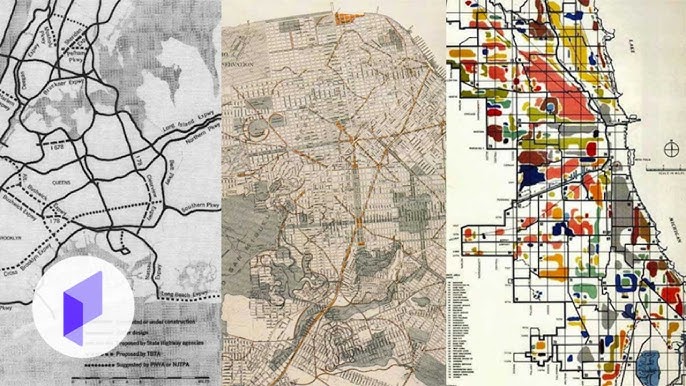The Evolution of Planning
Discussing and Exploring the Perils of Planning in the 20th Century
Tanisha Singh
5/3/20258 min read


Introduction
Perils of Planning in the 20th Century
The end of the 20th Century brought about a significant shift in the ways of planning and architecture. While this new rationale drew its inspiration from the existing industrialized cities, the newly planned cities gyrated more towards the ideologies of the Garden City, the Rationale City, and the City Beautiful models (Fishman,2016). The reforms in the planning profession progressed significantly in terms of its technical arguments against the existing cities that were a direct result of the Industrial Revolution that took place in the early 19th century. Due to the mushrooming of factories, mills, and industries catering to the mass production needs of food, clothing, metals, and many other daily use items, there was a major influx of people moving into these cities to find better job opportunities and establish better living conditions for themselves and their families. The revolutionary steam engine, helped millions of immigrants from faraway lands, take trains in bulk to travel to avail better opportunities.
However, as these cities grew into megacities, the sea of people moving in to reside in these cities and clustering the neighboring satellite cities began to over-densify the areas straining the existing utilities and services. The accommodation of this new increased population and catering to the basic requirements for these people like housing, services, transportation, and other basic, but major services became a daunting task for the local municipalities.
With such large-scale industrialization, came a large set of major challenges for the planners and the municipalities. Housing this influx of people was a top priority along with setting up decent working conditions, addressing noise concerns from these mammoth factories, the pollution from the factories, and the unsanitary living conditions. Soon the cities and the satellite cities saw the unauthorized settlement of small communal spaces and neighborhoods. There were people from different religions, descents, and colors, trying to find a space to call their own in these new melting pots of population.
This population growth was at such a rapid speed and at such a high rate, that laying out proper planning principles to settle them was next to impossible. This is one reason why it was quick and efficient to create housing that would allow maximum occupancy without much spatial need considerations of implementation of good planning policies. There were overcrowded crammed communities established that would house the labor class. This also contributed to the urban sprawl due to the occupying of fertile lands on the outskirts of the megacity to allow for short commutes to these work hubs.
The overall lack of proper planning framework and effective policies to handle this surge of construction and housing densification, poor urban infrastructure, and ignorance towards the environmental issues being raised due to this transformation was the key element that propelled planners like Ebenezer Howard and Le Corbusier and their followers into drafting concepts like the Garden City, Rational City or City Beautiful movements.
Social Dimensions of Urban planning
While urban planning has become one of the fastest-growing fields in the history of the transformation of cities, it is not surprising that the basics of planning have always been very logical. Logical in its terms and ways relating to the changing times and ideas and ideologies of developments in the cities. The changes have always been a result of social dysfunction or the culmination of social activities that have brought the ideas of “change” or “planning for better” into the picture. At every stage in the history of planning, whether it was the medieval times or the renaissance, or the formation of the earliest cities, the social fabric and the social dimensions of any city are what drive its developmental progress.
As most of the population moved from rural areas into better-paying cities, the evolution in the transportation system improved and accommodated for more economical and longer travel, and the social connections between the people gained momentum. The settlements further created, for the people moving in by the numbers, created a social fabric that became a melting pot. While this forced settlement lacked the quality of shelter and local services, poor health series and unsanitary living conditions, and unsafe areas with security concerns, it also in some ways gave birth to segregation and classification amongst the population. The failed planning considerations of the time did not consider assessing or monitoring the impact of such settlements on the social fabric of the cities. Hundreds worked in these mills and yards and lived closer to the work yet, there was spatial segregation that widened by the day. There was segregation based on class, superiority, seniority, and race. The workers usually lived a stone’s throw away from their employers, yet the living conditions were a stark contrast. This further fueled the segregation mentality.
It was not until planners like Ebenezer Howard, Frank Lloyd Wright and Le Corbusier went on to acknowledge the ramifications of these poor living conditions in the cities and study both, the positive and the negative impacts of these developments and implement them into their ideologies in planning cities that understood the social impacts of urban planning. It was in the 1930s, at the time of the emergence of their new concepts of cities that were a direct response to the failed industrial cities, that the considerations to planning in context with better housing, better local services, sanitary living conditions, secure cities, greener cities with better congregational spaces that acted like the lungs of the cities, better environmental living conditions and other factors were penned down to upgrade the social impact of what was done before (Sairinen,2004).
It was the vision of these future great planners to devote all of their time and grey matter to evolving detailed layouts for the existing factories, mills, and industries while adding newer office buildings for other small-scale businesses, schools for the younger population, parks as breathing spaces and more approachable and convenient transportation systems (Fishman,2016). These were the innovative ideas and designs the heavily industrialized cities needed to break free from the horrible living conditions they were set up as and to strengthen the social fabric of these cities.
Political agendas overshadowing City growth
While the upsurge of industries was the chief contributor to the industrious growth of concentrations of population in the 19th century, it was also vastly endowed by the copious amount of boom these factories and businesses brought to these cities. There were large enterprises that steamed out because of these large industries. There were massive profits made but mostly to the landlords, the owners, the employers, or the superiors. While the rich got richer with wealth and they displayed their luxuries, there was an underlying growth of this wealth being shared with the politicians and the municipal leaders. It seemed like it became easier to buy the approvals for the factories and the land and the unwanted development around it by buying into the system. Red-tapeism was at its peak.
With the upper class getting wealthier and enjoying their wealth and displaying it, the poor got poorer. They were shoved into slums that were congested and unkept and were the powerhouse for diseases and outbreaks. There was corruption and exploitation. While the talks of improvements were always on the horizon, no steps were taken to implement the plans that were discussed.
All this tense atmosphere and conditions and the social impacts of it on society as a whole and the uproar against the brutal conditions and the lack of wages resulted in the advocacy of sustainable development. It is around this time that the origins of planning in terms of reforms in social movements took place (Fainstein, 2022). This was to improve the standards of living for everyone, not just the wealthy. This movement was also to combat the ills of the disorders of the industrial city, which was now beginning to rise.
It was clear that even though these cities were popular and brought a great amount of wealth and capital to the city, most of it was disbursed to the municipalities and the rich. By now it was also clear that it was only these cities that were thriving. As swarms of people moved out of smaller cities to these new work magnets, the smaller cities suffered furthermore as there were no means of income generation or labor in the cities to carry on. There was no diversification of job opportunities, and the industrialized cities were so overpopulated that there weren’t enough jobs for the people who had moved into these areas. This resulted in supporting social inequity in these areas furthermore and in some contexts has lasted as long as today.
Economic viability and Sustainiablity
With all the disposition in the economic fabric of the cities, it was clear that urbanization in the 20s was at a massive scale and was a huge success at capital generation. However, it was also getting clearer that this wealth generation was eminently diverse and quite uneven (Belshaw, 2016). The distribution of wealth and the economic stability of each city was very different from another. The distribution of funds and their application to civic amenities or social equity was also evidently quite in contrast when it came from the bigger cities to smaller cities as well as within classes in the same city.
The larger cities and their growth, development, and expansion dwarfed the economic health of smaller cities. The class division gap also widened as the developed cities or sections within cities that hosted the wealthy population flourished while the lower classes suffered in inhospitable conditions that were very different.
The municipalities in the industrialized cities grew stronger and became so powerful that it was easy for them to influence the form and the economic restructuring of these cities. The top officials were able to steer the funds and the money toward their choice of a local project instead of utilizing it for the benefit of the city as a whole (Larson, 2009). The rapid immigration that took place during this time brought in immigrants that were new to these cities, were poor and lacked political sophistication with a major language barrier. It became easy for the political leaders to buy into this vote bank to fill their pockets and utilize this money to satisfy their own political and economic agendas leaving the city eponymically unviable in the long run. Most of this economic growth and fund circulation was seen at the local level and not accounted for any of the larger scale, socially equitable projects like transportation improvisations or creating better housing or creating parks, or other projects.
Conclusion
The industrialized cities, as powerful as they were and as economically prosperous, as they became, they lacked the basics of an ideal city. At the turn of the century, planners like Howard, Wright, and Corbusier identified the fact that their society needed better cities, transformed cities that rid this plague of social conflicts and misereres and class divide. The degraded conditions of the current cities seemed too overwhelming to reform and the idea of gradual transformations was an uphill task in terms of time, money, and work.
They understood human nature and the strength of a well-knit social fabric. Social equity was their priority as it helped bring people together and build sustainable societies. They figured out that their projects were fated to fail if the core of the plans were segregation based on class, color, income, or other factors. As Fishman (2016) quoted, “Good planning was indeed efficacious in creating social harmony, but only if it embodied a genuine rationality and justice in the structure of society” (Fishman, 2016). The Garden city, the City Beautiful, and the Rational City ideologies, and movements may have aimed at eliminating major barrios and resolving issues that tainted the industrialized cities, but they came with their challenges that were indeed challenged on many grounds, but at the time these models were a breakthrough and were exactly what the system needed. They may not have been successful in some principles, but they did manage to sustain some of their ideologies even in today’s age of planning.
References
Belshaw, J.D., (2016). Urbanization and Industry. Canadian history: post-confederation.
https://opentextbc.ca/postconfederation/chapter/3-5-urbanization-and-industry/
Fainstein, Susan S. “urban planning”. Encyclopedia Britannica, 13 May. 2022,
https://www.britannica.com/topic/urban-planning. Accessed 16 November 2022.
History of urban planning. (2022, Nov 15). In Wikipedia.
https://en.wikipedia.org/wiki/History_of_urban_planning
Hourihan, K., (2000, December). Urban Planning in the twentieth century. Urban History. Cambridge University Press, 27(3), 384–396.
https://www-jstor-org.proxy.lib.uwaterloo.ca/stable/44613174?read now=1&seq=1#page_scan_tab_contents
R. Fishman (2016 [1982]) ‘Urban Utopias in the Twentieth Century: Ebenezer Howard, Frank Lloyd Wright, and Le Corbusier’, in S. S. Fainstein and J. DeFilippis (eds) Readings in Planning Theory (4th Edition). Malden, MA: Wiley-Blackwell, 23–50.
R. Sairinen, (2004). Social impact assessment in urban planning. Centre for Urban and Regional Studies.
https://www.witpress.com/Secure/elibrary/papers/SC04/SC04042FU.pdf
S. Larson (2009) ‘Whose City Is It Anyway? Jane Jacobs vs. Robert Moses and Contemporary Redevelopment Politics in New York City’, Berkeley Planning Journal 22, 33–41.




